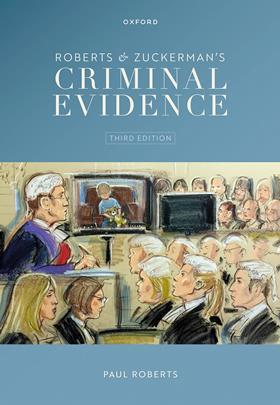Grounded analysis that is a pleasure to read
Roberts & Zuckerman’s Criminal Evidence — 3rd edition
Paul Roberts
£140, Oxford University Press
★★★★★
The third edition of Roberts & Zuckerman’s Criminal Evidence, now authored by Paul Roberts, is most welcome. Roberts has comprehensively revised the 2010 edition, while aiming to retain important historical material to show the evolution of law, and to facilitate before-and-after comparisons of pivotal legislative reforms. This incisive and insightful perspective, conveyed with vivid and witty writing (not least in the footnotes), is evident throughout.

Many criminal barristers will agree with Roberts’ opening observation that there continues to be a discernible shift in appellate jurisprudence to treating decisions on the facts as exemplars of the proper exercise of trial judges’ discretion, rather than as binding ‘precedent’ in the traditional common law sense – often warranting the view that a particular new decision has contributed little to the existing doctrinal corpus. Nonetheless, the 12-year gap since the last edition has enabled a valuable retrospective of what Roberts calls the ‘doctrinal reset’ engineered by the Criminal Justice Act 2003. This makes the chapters on character (for example, on ‘similar fact’/propensity evidence, and cross-admissibility) and hearsay evidence particularly informative. The same may be said of the chapter on vulnerable witnesses and the fate of the principle of orality, under the ever-expanding special measures regimes; and the unnecessarily opaque and complex section 41 of the Youth Justice and Criminal Evidence Act 1999 governing the admissibility of previous sexual behaviour evidence. Roberts’ expertise in forensic evidence makes the chapter on opinion evidence exceptionally illuminating. Every analysis is tied back to the fundamental precepts of a fair trial.
This is not a quick reference for a barrister heading into court or madly briefing a point the night before, or for a trial judge having to make a quick ruling. It does not purport to supplant Blackstone’s Criminal Practice or Archbold’s, but has the latitude to provide more searching and comprehensive analytical context. Practitioners preparing a complex case or appeal on a point of law, or who want an intellectually stimulating refresher, will enjoy it immensely. The frequent citation of empirical research into the operation of particular evidential rules provide a grounded analysis which practitioners will often recognise.
For students studying bar or solicitors vocational courses, perhaps encountering the law of evidence for the first time, this is an exemplar of powerful academic writing. It proves on every page how exciting, rather than intimidating, turgid and technical, this area of law really is.
Laura Hoyano is a barrister at Red Lion Chambers and an emeritus professor of Law at University of Oxford’s Faculty of Law































No comments yet